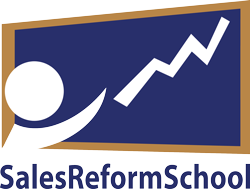When inbound leads from marketing just aren’t cutting it, do you work with internal sponsors and trusted advisors for referrals to grow your business? Or, do you do it the old-fashioned way and cold call and email blast your market? My friend, social media extraordinaire Barbara Giamanco, recently posted correctly that the best two ways in b2b sales to “get to the right decision maker fast, shrink sales cycles and close business more quickly” is either through a sponsor at the target or a referral from a trusted third party.
Totally agree. Fantastic advice.
One Question:
How do we do that?
Well, now the rest of the story. 
Sponsors at the Target Prospect
Sponsors at a target prospect fall into two categories: Business and Personal.
Business Sponsors
Business Sponsors are those who have enjoyed the benefits of your offering(s)’ capabilities already and are willing to sponsor you in another part of their organization. These individuals are willing to sponsor you because you have helped them in the past with overcoming an issue or challenge or reaching a goal or objective. These sponsors, however, may or may not have the clout to just suggest a meeting between you and the decision makers and make it happen.
To increase the probability that your sponsor gets you a meeting, you need to first collaboratively build the sponsor’s success story. The success story arms your sponsor with a rationale for pushing for the introduction – he helped me, he can help you. Since it will be based in fact and told by a co-worker, the story will help you build an emotional connection between you and the decision makers without you even being there.
This conversational success story should brief enough to be told in a five minute meeting between your sponsor and a decision maker perhaps over coffee, at lunch or during a more serious meeting.
To write it, come to agreement with your sponsor and draft the following:
1) The sponsor’s goals or objectives before you started to work together.
“Back in 20–, we knew our company needed to improve/increase/decrease….”
2) What was the business problem or issue prior to our working together? You should be able to describe in two or three sentences the crappy situation they were in.
3) What capability or set of capabilities did they need to bring on board? Simply,
“when faced with … we needed to be able to ….”
4) The tangible and intangible payoff or payback.
“Once we implemented or bought from xxx, we increased/decreased/improved ….”
This puts the cost v. benefit on the table and implies that the decision maker would be smart to meet you.
Once the Business Sponsor has this story in hand, he can confidently make the introduction for you and ratchet up the probability of your getting a meeting with the decision maker.
Personal Sponsors
Personal sponsors are friends and loved ones with whom you have a personal relationship but have not yet helped in a business sense. You are trying to get your personal sponsor to say to a decision maker,
“Hey, you should meet with Adam. He is a bright guy, maybe he can help us.”
Will that be enough? Maybe.
To turn that “maybe” into a probably, you still need to arm your Personal Sponsor with a story. In fact, it may be more important. Personal relationships are great, but in today’s busy world, might not be enough to get you a meeting. In fact, it may be a detriment. Cynical decision makers may think your sponsor is solely trying to help because it’s personal. Decision makers every day need to determine who they will or will not have conversations. So, give your Personal Sponsor some help in the form of a success story fashioned like the one above only describing another similar company’s success. Alternatively, work with the personal sponsor to write a usage story for the sponsor’s company. This will turn the personal sponsor into a business sponsor.
The sponsor’s usage story goes something like this:
“You know how we are struggling with …. We can’t stand it when….Well, my friend/relative Adam Shapiro says that when his clients are/have been in that situation, he provides then with…..He says they enjoy an increase/decrease/improvement in…. to the tune of …..Can I suggest he contact you to set up a conversation to see if our situation is similar?”
With either the similar success story or the usage story, you can turn your personal sponsor into a business sponsor.
Referral from a Trusted Third Party
Direct Referral
You know someone who not only knows your target’s decision maker, but is in a position of trust with that person. We can call this person “TA”, for “Trusted Advisor.” You want TA to make a Direct Referral for you. In a very similar fashion to the sponsor scenario, the big question then is, “Can TA tell your story and get you that meeting?” Just in case TA is not at a consigliere-Tom Hagen level, I suggest arming him with as well with some of your conversational success stories or usage stories to re-tell during the referral. It will make it easy for the decision maker to agree with TA that he should talk to you.
Indirect Referral
But, what if instead of a direct referral, TA authorizes YOU to reach out to the decision maker and mention that TA suggested you contact them? This is the Indirect Referral.
In your opening remarks, voice mail or email, offer a success story or usage story.
It should go something like this:
“TA heard about my success helping other companies overcome …. And felt you would want to learn more. In one such situation, they were struggling with ….needed…. we provided them with the capabilities they needed and now they’ve improved/increased/decreased….”
“After hearing this story, TA suggested I contact you.”
Careful, though. In this situation, you also need to make sure TA is familiar with your success and usage stories because you have to anticipate that the decision maker will seek out TA for confirmation. Help you and TA save face by having a preparatory conversation first before contacting the decision maker.
So, I agree. Follow Barb’s advice that if you want to sell more, faster, and to the right people, you will need sponsors and referrers. Your sponsorships and referrals will be strongest and get you to decision makers faster, though, if you give create and deliver meaningful content in the form of success and usage stories as described above.
Good Selling.
